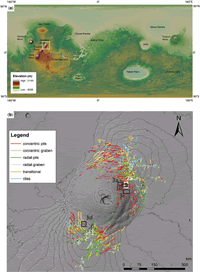Self-similar clustering distribution of structural features on Ascraeus Mons (Mars): implications for magma chamber depth.
Pozzobon R., F. Mazzarini, M. Massironi, L. Marinangeli (2015).
From: Platz, T., Massironi, M., Byrne, P. K. & Hiesinger, H. (eds) 2015. Volcanism and Tectonism Across the Inner Solar System.
Geological Society, London, Special Publications, 401, 203-218, doi:10.1144/SP401.12.
Abstract
The occurrence and distribution of monogenic eruptive features in volcanic areas testify to the presence of deep-crustal or subcrustal magma reservoirs hydraulically connected to the surface via a fracture network. The spatial distribution of vents can be studied in terms of self-similar (fractal) clustering, described by a fractal exponent D and defined over a range of lengths (l) between a lower and upper cutoff, Lco and Uco, respectively. The computed Uco values for several volcanic fields on Earth match the thickness of the crust between vents and magma reservoirs at depth. This analysis can thus be extended to other volcanic fields and volcanoes on rocky planets in the solar system where features such as vents and dykes occur, and for where complementary geophysical data are currently lacking. We applied this method to the Ascraeus Mons volcano on Mars, which presents hundreds of collapse pits similar to those observed on Earth volcanoes that are most likely related to feeder dykes. Based on structural mapping with High Resolution Stereo Camera data at 12 m/px and Context Camera data at 6 m/px mosaics, more than 2300 collapse pits and dyke traces were analysed, revealing two distinct fractal clustered populations. The obtained Uco values reveal the presence and likely depth of both a deep magma reservoir (c. 60 km deep) and a small shallower chamber (c. 11 km deep). This analysis can help to better constrain the depth and time evolution of volcanic processes on Tharsis, and on terrestrial planets’ volcanoes in general.
http://sp.lyellcollection.org/content/401/1/203.abstract?sid=6122dd2d-741b-4e4c-9bb4-0ec0a506da24


